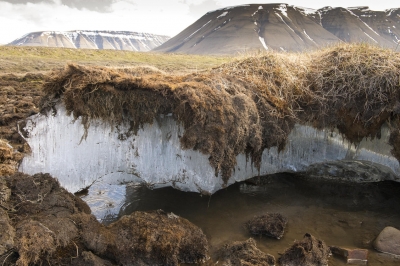
Permafrost is permanently frozen ground comprising soil, rocks, and sand, and often spans the Arctic regions. Found both on land and below the ocean floor, it covers vast expanses, and is a habitat for several animals and plants. Melting permafrost is a concern because it releases vast amounts of trapped greenhouse gases into the atmosphere.
What is Permafrost Made Of?
Permafrost is made of a combination of soil, rocks and sand that are held together by ice. The soil and ice in permafrost stay frozen all year long.
Near the surface, permafrost soils also contain large quantities of organic carbon—a material leftover from dead plants that couldn’t decompose, or rot away, due to the cold. Lower permafrost layers contain soils made mostly of minerals.
A layer of soil on top of permafrost does not stay frozen all year. This layer, called the active layer, thaws during the warm summer months and freezes again in the fall. In colder regions, the ground rarely thaws—even in the summer. There, the active layer is very thin—only 4 to 6 inches (10 to 15 centimeters). In warmer permafrost regions, the active layer can be several meters thick.
How Does Climate Change Affect Permafrost?
As Earth’s climate warms, the permafrost is thawing. That means the ice inside the permafrost melts, leaving behind water and soil.
Thawing permafrost can have dramatic impacts on our planet and the things living on it. For example:
- Many northern villages are built on permafrost. When permafrost is frozen, it’s harder than concrete. However, thawing permafrost can destroy houses, roads and other infrastructure.
- When permafrost is frozen, plant material in the soil—called organic carbon—can’t decompose, or rot away. As permafrost thaws, microbes begin decomposing this material. This process releases greenhouse gases like carbon dioxide and methane to the atmosphere.
- When permafrost thaws, so do ancient bacteria and viruses in the ice and soil. These newly-unfrozen microbes could make humans and animals very sick. Scientists have discovered microbes more than 400,000 years old in thawed permafrost.
- Because of these dangers, scientists are closely monitoring Earth’s permafrost. Scientists use satellite observations from space to look at large regions of permafrost that would be difficult to study from the ground.
Credit : Climate kids
Picture Credit : Google




